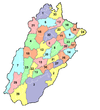Mandi Bahauddin
| Mandi Bahauddin منڈی بهاؤالدین | |
|---|---|
| City | |
 Mandi Bahauddin | |
| Coordinates: 32°35′N 73°30′E / 32.583°N 73.500°ECoordinates: 32°35′N 73°30′E / 32.583°N 73.500°E | |
| Country | Pakistan |
| Province | Punjab |
| District | Mandi Bahauddin District |
| Established | 1506 AD |
| NA/PP | 2/5 |
| No. of Towns | |
| Government | |
| • Type | City District |
| • Union Councils | 27 |
| Area[1] | |
| • Total | 7,623 km2 (2,943 sq mi) |
| Elevation | 204 m (669 ft) |
| Population (1998) | |
| • Total | 1,160,552 |
| • Density | 150/km2 (390/sq mi) |
| Demonym | Bahauddinian |
| Time zone | PST (UTC+5) |
| Postal code | 50400 |
| Dialling code | 0546 |

Mandi Bahauddin (Punjabi, Urdu: منڈی بهاؤالدین) is a city in central Punjab, Pakistan.It is also the capital of Mandi Bahauddin District.The city is some 220 metres above the sea level and is located in central Punjab, between the rivers Jhelum (north 12 km) and Chenab (south 39 km). The city of Mandi Bahauddin had contained no traffic lights up until February 2010 when the first set of traffic lights was installed at the major intersections.
Administration
Mandi Bahauddin, the capital of the district, is also the Tehsil headquarter. Mandi Bahauddin Tehsil has 27 Union Administrations / Union Councils.[2]
History
Early history
In 1506 AD Hazrat Bahauddin a Sufi Darvesh established a settlement namely Pindi Bahauddin in the north-eastern corner of the region known as "Gondal Bar", after his immigration from Pindi Shah Jahanian to this area. The settlement soon became a center of intense commercial activity, hence named afterwards by the merchants as "Mandi Bahauddin", the Market of Bahauddin. The Urdu word "Mandi" implies "marketplace". The proto-city was later on fortified with 9 main doorways to guard against foreign invasions. The wall intact today was completed in 1946.[3]
However, the recorded history of Mandi Bahauddin goes back to the era before Common Era, connecting the region with the historic figure of Alexander the Great. Some 8 km northwest of the modern-day Mandi Bahauddin town, village Mong on the southern bank of Jhelum River (Greek Hydaspes), the battle Battle of the Hydaspes River was fought between Raja Porus (Sanskrit Paurava) and Alexander. This historic battle of Hydaspes River, which Indian sources refer to as the "Battle of Jhelum", took place in 326 BCE.[4] The kingdom of Raja Porus was situated in the northern Punjab of modern Pakistan. This battle proved the last major fight of Alexander's career, for the Macedonians, after being put up a fierce resistance by Porus' soldiery and having heard of a massive 4,000 elephant force mustered by eastern kingdoms, refused to march further east i.e. Ganges Plains.[5]
After independence
The predominantly Muslim population supported Muslim League and Pakistan Movement. After the independence of Pakistan in 1947, the minority Hindus and Sikhs migrated to India while the Muslims refugees from India settled down in Mandi Bahauddin District. In 1963, the Rasul Barrage and Rasul-Qadirabad Link Canal project under the Indus Basin Irrigation Project started. The project was managed by Water and Power Development Authority (WAPDA), and a large colony for government employees and foreign contractors was constructed 2 kilometres north of Mandi Bahauddin city. This project was completed in 1968 by Engineer Riazur Rahman Shariff as the Project Director. This project brought Mandi Bahauddin into limelight and helped the city grow commercially.[6] Mandi Bahauddin is also having the only manufacturing unit of Food Dyes in Pakistan named as Rainbow Dye-Tech (Pvt.) Ltd.
The Tehsil headquarters towns of Phalia and Malikwal are 22.5 and 28.5 kilometres from Mandi Bahauddin, respectively.[7] The Mandi Bahauddin Tehsil has 27 Union Councils.
References
- ↑ http://www.census.gov.pk/PUNJAB/MANDI%20BAHAUDDIN.htm
- ↑ Tehsils & Unions in the District of Mandi Bahauddin – Government of Pakistan
- ↑ http://www.findpk.com/cities/Explorer-pakistan-Mandi%20Bahauddin.html
- ↑ Kaushik Roy, India's historic battles: from Alexander the great to Kargil, Delhi: Permanent Black, 2004, p.11
- ↑ Ruth Sheppard, Alexander the Great at War: His Army – His Battles – His Enemies, Oxford: Osprey Publishing, 2008, p.206
- ↑ History of Mandi-bahauddin By M. Umer Azam, Nazar Muhammad Cheema & Addition and Revision by S.T. Shah
- ↑ Review City
| ||||||||||||||||||||
| |||||||||||||||||||||||||||

